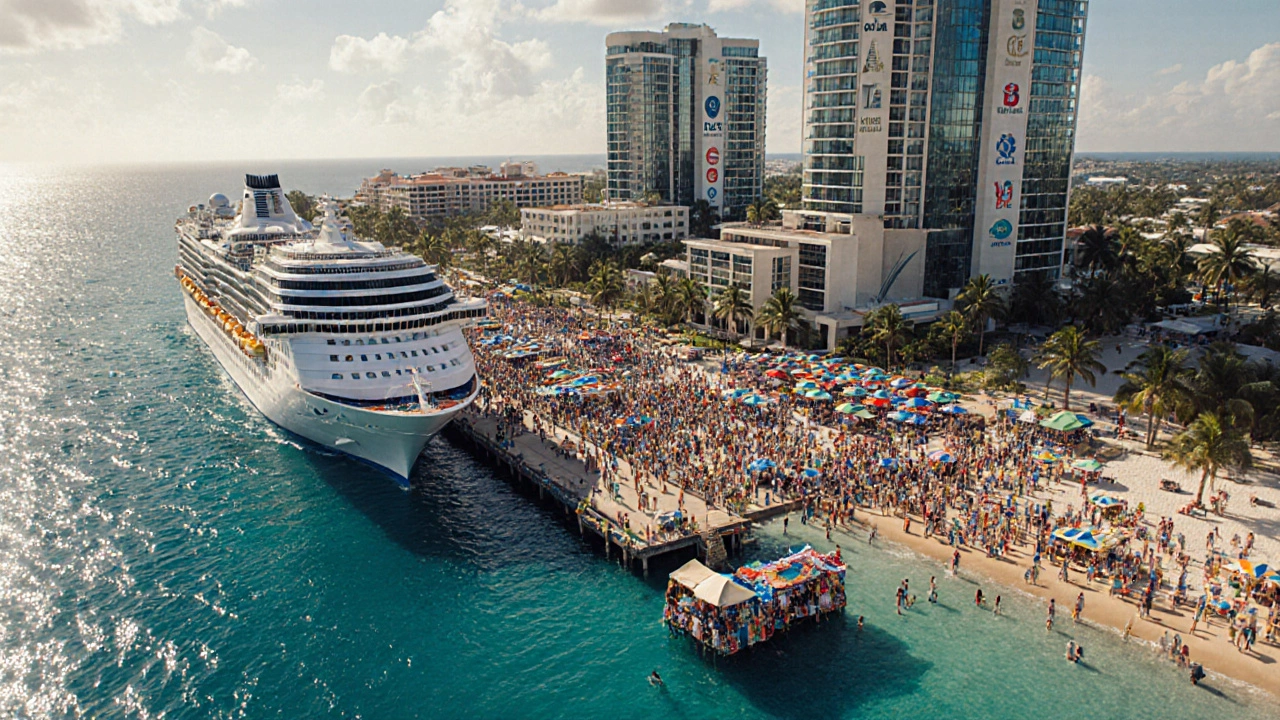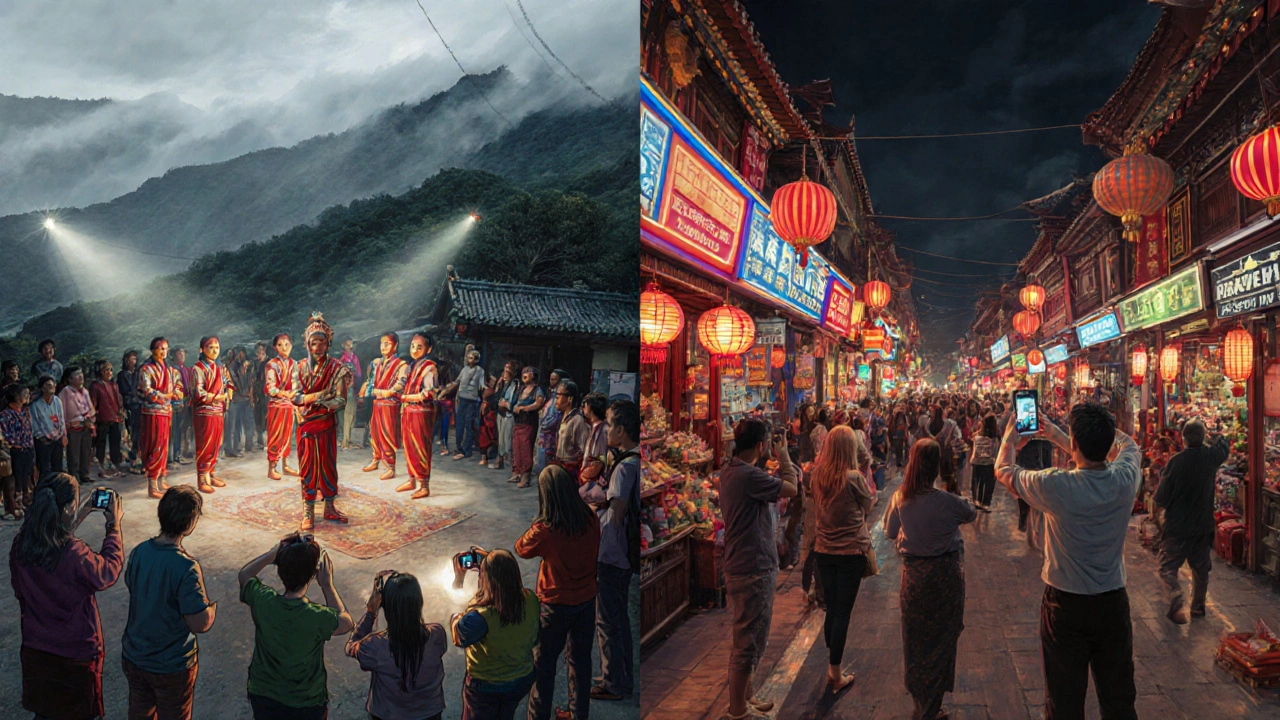Disadvantages of Cultural Tourism: What Travelers Should Know

- Oct, 12 2025
- 0 Comments
- Aaron Blackwood
When travelers chase immersive experiences, Cultural tourism is the practice of visiting destinations to engage with their heritage, arts, customs, and everyday life. While the idea sounds enriching, the reality often includes a set of hidden costs that affect locals, environments, and even the authenticity of the culture itself.
Economic Drawbacks that Ripple Through Communities
One of the first warnings comes from the money trail. Economic leakage describes how a large share of tourist spending ends up in foreign hands-think multinational hotel chains, tour operators, and souvenir manufacturers that import their goods. In a 2023 study of Caribbean cruise ports, roughly 65% of tourist dollars left the islands within the first week of arrival, leaving local vendors with a modest slice of the pie.
Beyond leakage, the rise of gentrification can push up real‑estate prices, making it harder for longtime residents to afford their own neighborhoods. A street in Oaxaca that once housed family‑run craft workshops now hosts pricey boutique hotels, forcing artisans onto the city’s fringe.
Social and Cultural Impacts that Erode Authenticity
Travelers often love the idea of “authentic” experiences, yet they can unintentionally trigger cultural appropriation. When foreign visitors dress in traditional garments without understanding their symbolism, it can dilute sacred meanings and offend community members. In Thailand’s hill tribes, tourists photographing ceremonies without permission have sparked protests against commodified rituals.
Another subtle shift is the loss of authenticity. To cater to demand, some heritage sites re‑stage performances, simplify narratives, or alter architectural details. The “re‑created” market streets of Beijing, designed for photo‑ops, often bear little resemblance to their historic counterparts and risk turning culture into a theme park.
Environmental Concerns Tied to Visitor Flows
High foot traffic leads to wear and tear on fragile structures. Heritage sites like the ancient city of Hampi in India have reported stone erosion after millions of tourists walked the same paths daily. Dust, graffiti, and litter further strain conservation budgets.
Beyond the sites themselves, the sheer number of visitors fuels overtourism. Popular cultural festivals such as Spain’s La Tomatina can overwhelm local infrastructure, leading to traffic jams, water shortages, and increased waste. The carbon footprint of long‑haul flights adds another layer of ecological cost that rarely appears in promotional brochures.

Loss of Community Cohesion and Identity
When tourism becomes the dominant economic engine, community priorities shift. Younger generations may abandon traditional crafts in favor of hotel jobs, eroding inter‑generational knowledge transfer. In Bali, the rise of homestays has pushed many families to prioritize English‑language training over Balinese dance lessons, reshaping cultural identity over time.
Excessive focus on tourist expectations can also reshape daily life. Residents of historic districts in Rome have reported altered schedules to accommodate late‑night tours, disturbing the rhythm of normal neighborhood life.
Mitigation Strategies: Turning Challenges into Opportunities
Understanding the pitfalls is the first step toward smarter travel. Below is a quick‑reference table that outlines the major disadvantages, typical impacts, real‑world examples, and practical mitigation ideas.
| Disadvantage | Typical Impact | Example | Possible Mitigation |
|---|---|---|---|
| Economic Leakage | Local wealth drains to foreign operators | Caribbean cruise ports - 65% of spend leaves island | Promote locally owned businesses; certify “Buy Local” |
| Gentrification | Rising rents push out residents | Oaxaca street turned boutique hotel zone | Implement community land trusts; cap short‑term rentals |
| Cultural Appropriation | Misuse of symbols, offense to locals | Tourists in Thai hill‑tribe ceremonial dress | Provide cultural briefings; enforce respectful dress codes |
| Loss of Authenticity | Staged experiences dilute real culture | Beijing market streets re‑created for tourists | Support community‑led interpretation; limit commercial scripting |
| Environmental Degradation | Erosion, waste, carbon emissions | Hampi stone wear from daily foot traffic | Visitor caps; fees for conservation; promote low‑carbon travel |
| Overtourism | Infrastructure strain, resident inconvenience | La Tomatina causing water shortages | Advance ticketing; dispersing peak days; invest in public services |
For travelers, a simple checklist can help reduce negative footprints:
- Choose locally‑run tours and accommodations.
- Respect dress codes and photography rules at cultural sites.
- Limit visits to a single destination within a short time frame to avoid overtourism hotspots.
- Offset flight emissions through reputable carbon‑offset programs.
- Engage with community‑led workshops instead of mass‑produced souvenir shops.

Looking Ahead: Balancing Desire and Responsibility
There’s no denying that cultural tourism disadvantages exist, but they don’t have to eclipse the joy of learning about another way of life. By staying informed, supporting authentic experiences, and advocating for sustainable policies, travelers can help preserve the very cultures they came to admire.
Frequently Asked Questions
How can I tell if a cultural tour is authentic?
Look for tours run by community members, certified local guides, or organizations that profit‑share with the host community. Avoid operators that promise “instant” cultural immersion without any background on their staff.
What are the signs of overtourism at a heritage site?
Long queues, crowded pathways, visible wear on stone or artifacts, and a lack of local presence (e.g., few residents in surrounding neighborhoods) usually indicate overtourism.
Can my travel spending actually help preserve cultural heritage?
Yes, when you pay entry fees that go directly to site maintenance, purchase crafts from local artisans, or stay in community‑owned lodgings, a larger portion of your money stays in the local economy and fuels preservation efforts.
Is it okay to take photos of cultural rituals?
Only if you have explicit permission. Some rituals are sacred and prohibitions are meant to protect the community’s spiritual integrity. When in doubt, ask the guide.
What are some low‑impact alternatives to popular cultural destinations?
Explore off‑the‑beaten‑path towns, attend local festivals in smaller villages, or engage in community‑based tourism projects that limit visitor numbers while offering deep cultural exchange.